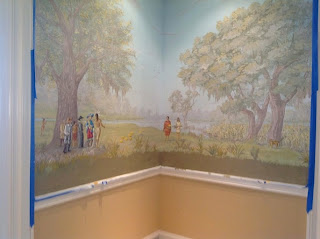Restaurant R’evolution’s design is central to the story we will tell about the history and contributions of the seven nations of Louisiana. Like our cuisine, the design celebrates and pays homage to Louisiana’s history while introducing contemporary, distinctive accents that “revolutionize” the classic dining experience, and make it truly unique.
While our job as chefs is to tell this story on the plate, we wanted to showcase this story “off the menu” as well. One of our goals was to communicate the cultural contributions of the seven nations of Louisiana through a mural that tells their stories visually. Our design team at The Johnson Studio, led by visionary designer Bill Johnson, enlisted the expertise of the accomplished Atlanta-based decorative artist and muralist Grahame Ménage for the task.
Set within the Storyville Parlor, the most elegant of R’evolution’s seven dining spaces, Grahame’s gorgeous mural artfully interprets the history of Louisiana cuisine through four one-of-a-kind murals that pay homage to the culinary traditions on which Restaurant R’evolution is based, adding an artistic, educational visual element to the dining experience that we can’t wait to share with you when we open next month! Read on for a detailed Q&A with Grahame about the inspiration behind our murals.
 |
Spain & Acadia: The Spanish grant land
to the Acadians
|
 |
Spain & Acadia: A work in progress
|
Can you tell us about the different murals?
I was immediately inspired upon meeting Chef Folse and quickly discovered his passionate, encyclopedic knowledge of Louisiana’s history and cuisine. Louisiana cuisine is three hundred years of local history in a bowl. So, the four murals were designed to tell the story of the seven global cultures that contributed the ingredients, techniques, and flavors that make Creole and Cajun cooking unlike any other.
The first mural shows Native Americans offering corn to the French. Next, we see the Spanish giving land grants to the Acadians. The third mural depicts settlers from Germany and England, bringing with them sausage production, pork roasting, dairy farming and, music making! And the final scene shows a Sicilian ship docked at New Orleans, bringing Italian immigrants who began working together with the free men of color.
 |
France & America: The preliminary sketch
|
 |
Germany & England: Germans bring pork roasting and music, English bring dairy farming and develop cotton plantations
|
What makes these murals “New Orleans?”New Orleans is one of the most culturally diverse cities in North America, where every ethnicity brings something unique to the table. The murals celebrate the historical roots of that diversity.
 |
Post-Civil War: Italian immigrants arrive and work with free men of color on New Orleans docks
We hope you’ve enjoyed learning a little more about a different side of Restaurant R’evolution, and heartily thank Grahame for his tremendous, inspiring work. We can’t wait to share it with you when we open on June 4!
Our best,
John & Rick
|




